Physical Address
304 North Cardinal St.
Dorchester Center, MA 02124
Physical Address
304 North Cardinal St.
Dorchester Center, MA 02124

Discover 21 kitchen backsplash ideas for modern smart homes that perfectly balance style with technology integration. From seamless slabs to textured tiles, find the ideal backdrop for your connected kitchen.
The kitchen isn’t just where we cook anymore—it’s command central for our connected homes. As a Smart Home Integration specialist, I’ve seen how the right backsplash can both protect your walls and provide the perfect backdrop for your tech-enhanced culinary space. Whether you’re planning a complete smart kitchen overhaul or simply updating your look, these 21 kitchen backsplash ideas for modern homes combine style with practical functionality that works seamlessly with today’s technology.
Subway tiles remain a timeless choice, but today’s tech-savvy homeowners are installing them with a twist. Vertical stacking creates height in smaller spaces, while herringbone patterns add visual interest without competing with your smart displays. Consider how different layouts affect the overall feel of your space—vertical arrangements can make ceilings appear higher, which is particularly valuable if you’re planning overhead smart lighting systems.
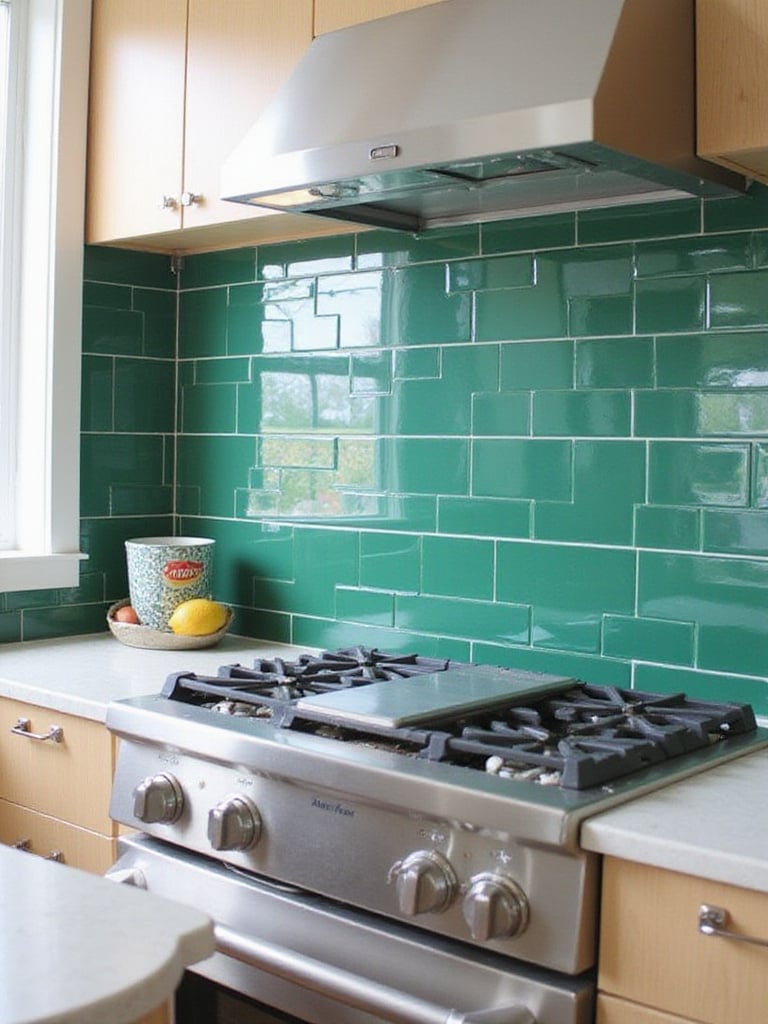
The color palette has evolved beyond basic white. Muted sage green complements the natural wood tones many smart speakers use, while deep navy provides striking contrast against stainless steel appliances. Remember that grout choice dramatically impacts the final look—dark grout with light tiles creates a graphic pattern that can visually anchor wall-mounted tablets or screens.
Look closely and you’ll notice how the subtle texture of these reimagined classics adds dimension without interfering with the clean lines needed for a tech-friendly kitchen environment.
For the ultimate in modern sophistication, nothing beats a slab backsplash. The uninterrupted surface creates the perfect clean backdrop for digital displays and smart controls. Without grout lines to distract the eye, your attention naturally flows to the technology that makes your kitchen smarter. This seamless look also makes cleaning infinitely easier—just wipe down the surface after cooking experiments go awry.
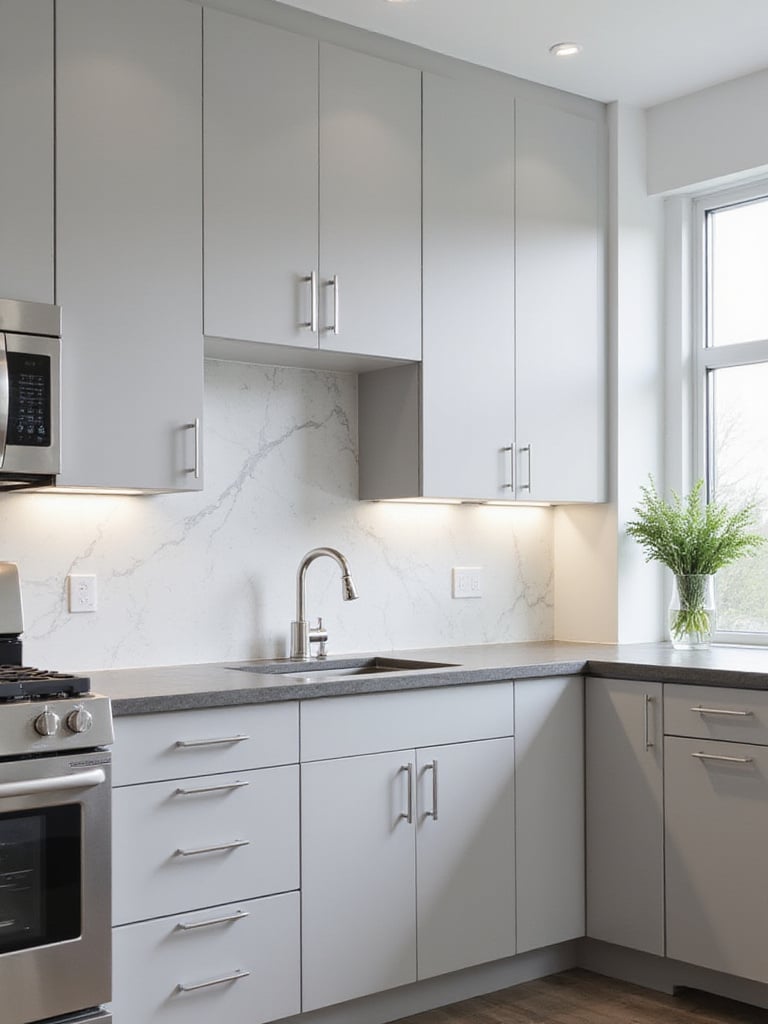
Material options include quartz for exceptional durability and stain resistance, granite for natural beauty with heat resistance, and large-format porcelain that can mimic more expensive materials at a fraction of the cost. Each offers different benefits depending on your priorities—quartz resists staining from cooking splatters, while porcelain can be manufactured with anti-microbial properties for the health-conscious smart home.
The environmental story behind your chosen material matters too—many manufacturers now offer recycled content options that reduce ecological impact while still providing the sleek, tech-friendly surface your modern kitchen deserves.
Geometric patterned tiles inject energy and visual structure into tech-heavy kitchens. Hexagons, triangles, and chevrons create dynamic backdrops that complement the angular design of many smart appliances. The key is balancing pattern scale with your kitchen’s dimensions—larger patterns make bold statements in spacious kitchens, while smaller, more intricate designs work better in compact spaces where your smart devices need to remain the focal point.
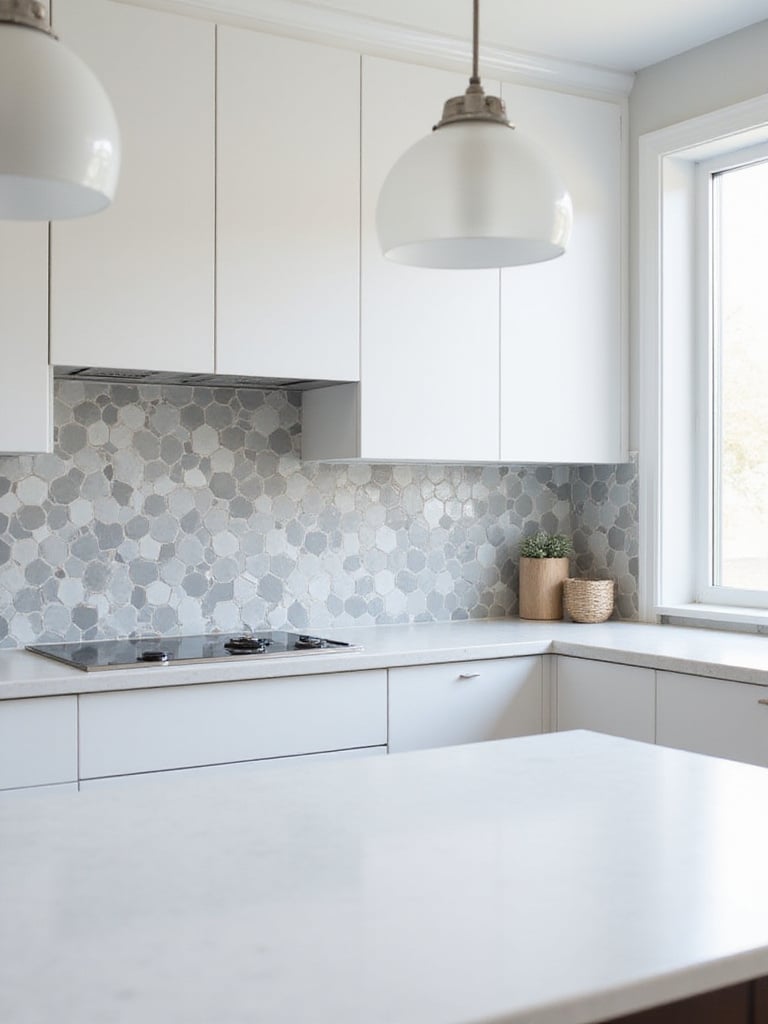
Material choices dramatically affect how these patterns integrate with your technology. Glass tiles reflect light and can enhance the visibility of digital displays, while matte ceramic absorbs light and reduces glare on screens. Consider how your backsplash will interact with the tech elements in your kitchen—will it compete for attention or create a harmonious backdrop?
Even in smaller spaces, here’s how geometric patterns work: they create visual zones that can naturally guide the eye to different functional areas of your smart kitchen, from cooking stations to digital hubs.
Strategic color use in kitchen backsplashes can transform how your smart technology integrates with the space. Emerald green or cobalt blue tiles create rich backgrounds that make stainless steel appliances and black smart displays pop. These bold colors can define zones in an open-concept kitchen—perhaps highlighting the cooking area where your smart range and digital temperature probes live.
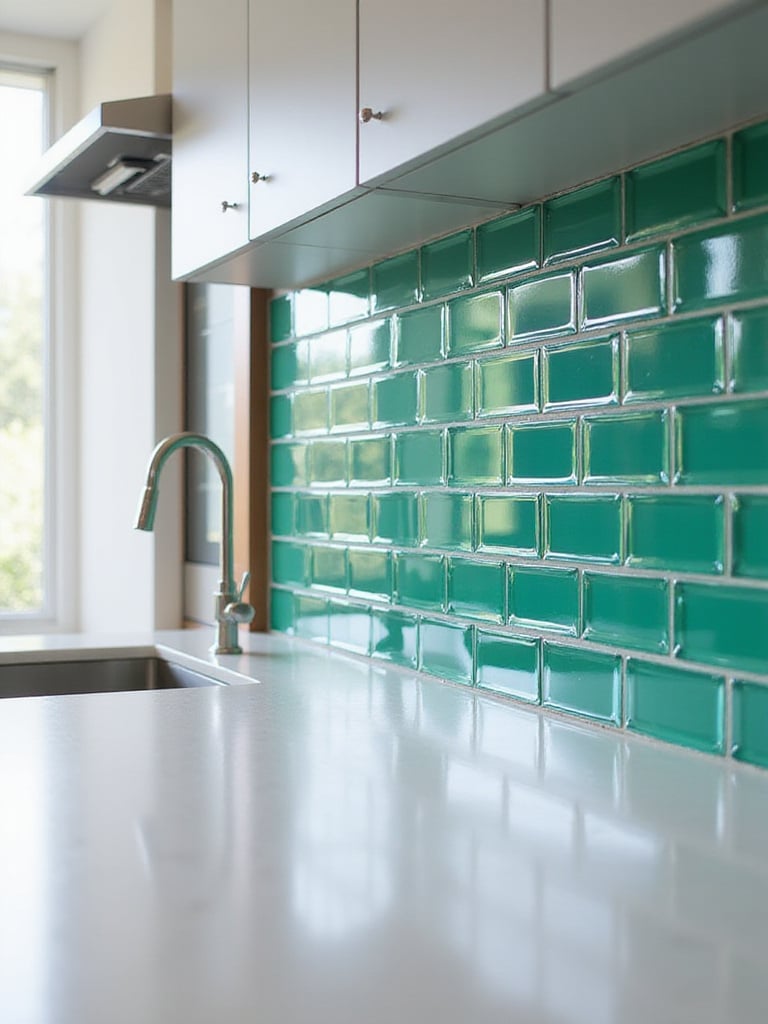
When selecting vibrant backsplash colors, consider your existing elements. Cabinet color, countertop material, and flooring all influence how a bold backsplash will read in the space. Test samples under your kitchen’s actual lighting conditions, as smart lighting systems can dramatically alter color perception throughout the day. What looks perfect under bright task lighting might appear entirely different when your automated lighting shifts to evening mode.
The unexpected environmental benefit comes from how well-chosen colors can reduce the need for artificial lighting—vibrant backsplashes can reflect your smart lighting more effectively, potentially reducing energy consumption in your connected home.
In kitchens increasingly dominated by flat screens and smooth smart devices, textured 3D tiles inject welcome tactile dimension. These tiles create fascinating shadow play as your smart lighting changes throughout the day, adding visual interest that flat surfaces simply can’t match. The interplay between physical texture and digital displays creates a balanced environment that engages multiple senses.
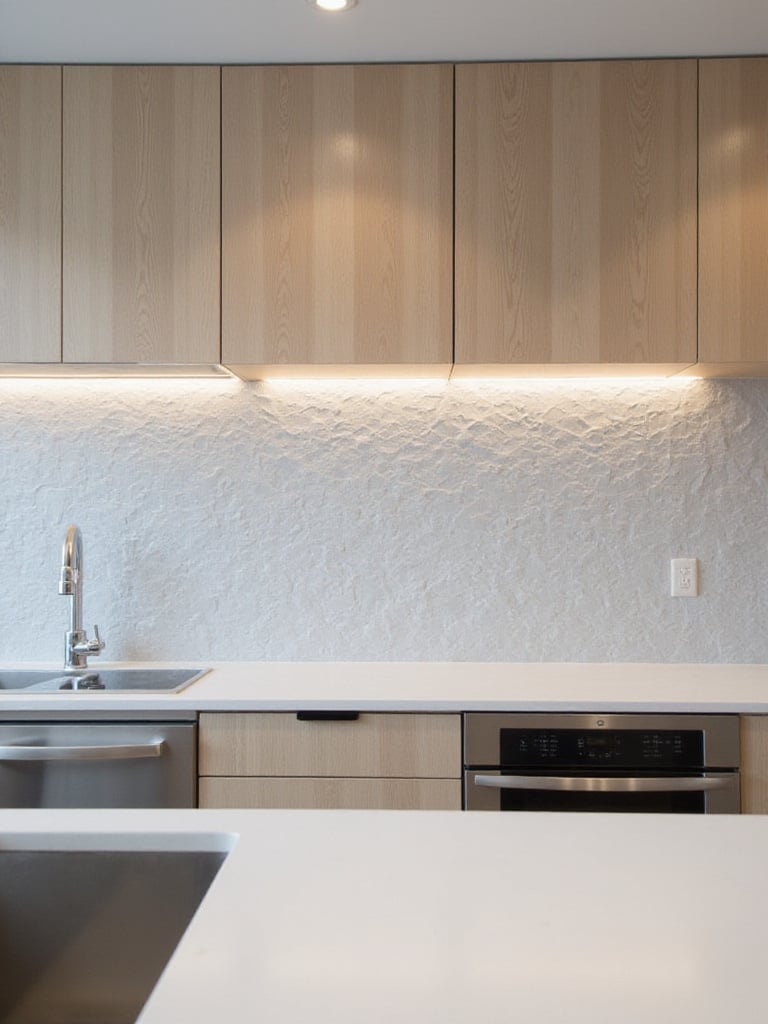
Popular 3D options include ceramic tiles with geometric relief patterns, glass tiles with rippled surfaces, and natural stone with cleft textures. Each brings different qualities to your kitchen—ceramic offers endless pattern possibilities, glass adds reflectivity that enhances light distribution from smart fixtures, and stone contributes natural variation that softens the tech-heavy environment.
The styling mistake most people make is overwhelming the space with competing textures. Instead, consider using textured tiles strategically around key technology integration points, creating intuitive focal areas around smart hubs or digital control centers.
Metallic backsplashes create natural harmony with the tech elements in modern kitchens. Stainless steel backsplashes echo the finish of smart appliances, creating visual continuity. Copper and brass options add warmth that balances the cooler tones of screens and digital displays. Even metallic-look ceramic tiles can achieve this effect while offering easier installation and maintenance.
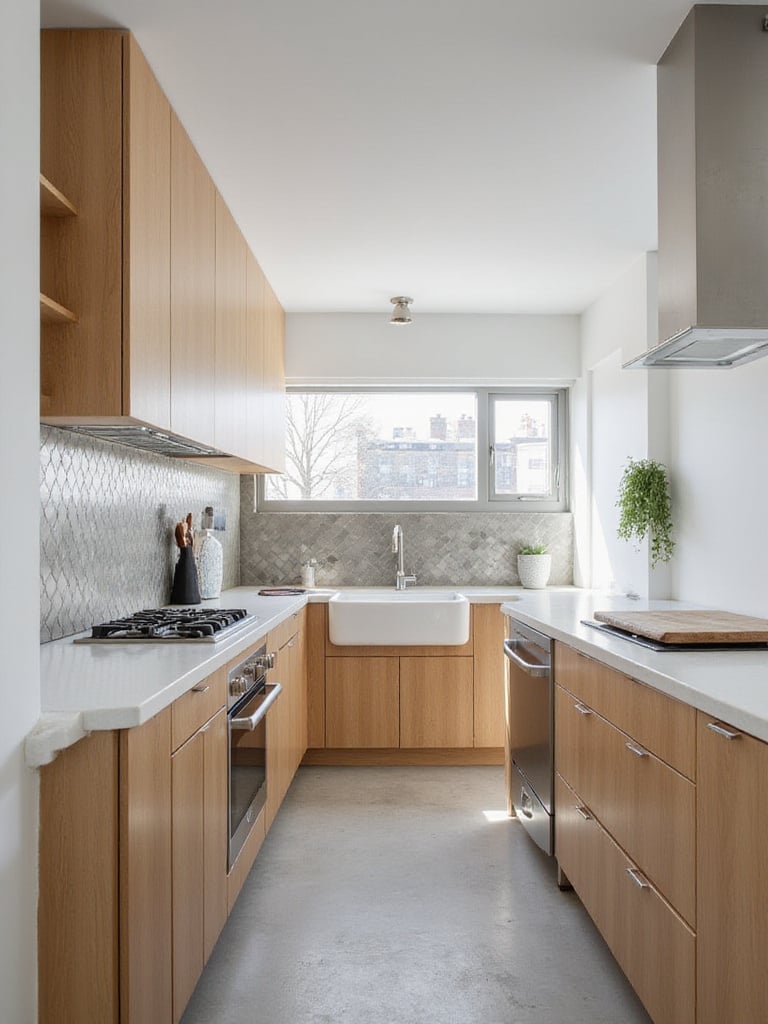
The versatility of metallic backsplashes might surprise you—they’re not just for ultra-modern spaces. Copper complements wood cabinetry beautifully, softening the technological elements in more transitional kitchens. Stainless steel paired with concrete countertops creates an industrial vibe perfect for loft spaces. The key is balancing the reflective quality of metals with other textures to prevent the kitchen from feeling cold or sterile.
Unlike conventional options, this approach reduces visual discord between your backsplash and smart devices, creating a more intentionally designed space where technology feels like an integrated feature rather than an afterthought.
Glass tiles are exceptional performers in smart kitchens where light management matters. Their reflective properties bounce both natural and artificial light around the room, maximizing illumination for cooking tasks and ensuring your smart displays remain visible without cranking up brightness settings. This light-enhancing quality can make smaller kitchens feel more spacious while reducing the energy needed for task lighting.

When selecting glass tiles for a modern kitchen backsplash, consider how different formats affect the overall aesthetic. Subway-style glass tiles in clear or frosted finishes offer a clean, minimalist look that won’t compete with your technology. Larger format glass panels minimize grout lines for easier cleaning and a more seamless appearance. Mosaic glass tiles in complementary tones can add subtle texture while maintaining the reflective benefits.
The maker’s journey from traditional to smart kitchen design often includes this revelation: glass backsplashes can help bridge the gap between classic kitchen elements and modern technology, creating spaces that feel both timeless and forward-thinking.
Natural stone backsplashes bring essential organic texture to kitchens filled with technology. The inherent variations in marble, granite, slate, or limestone create a grounding counterpoint to the precise lines of smart appliances and digital displays. This balance between natural and technological elements prevents your kitchen from feeling sterile or overly clinical.
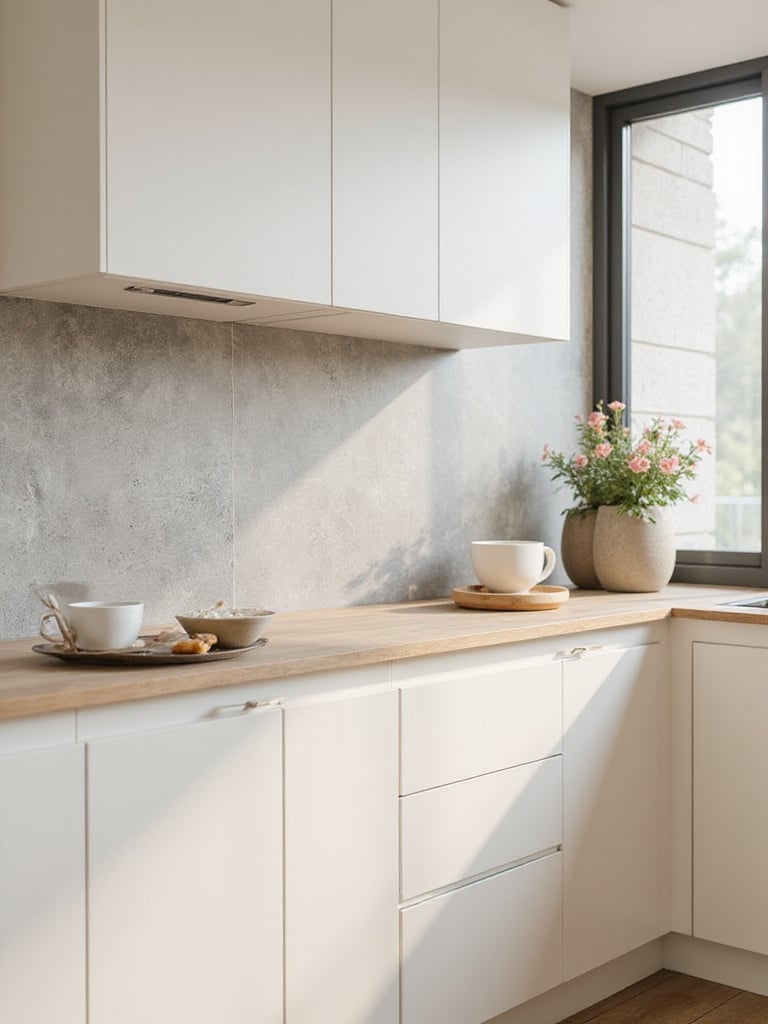
Different stone types offer varying aesthetics and practical benefits. Marble’s luxurious veining adds movement and visual interest, though it requires more maintenance. Granite provides exceptional durability with distinctive patterning. Slate’s rich, dark tones and textured surface add depth and rustic charm that can soften the high-tech elements in your kitchen. Consider how each stone’s natural characteristics will complement your smart kitchen’s overall design scheme.
When clients ask us about balancing style with comfort in their smart kitchens, natural stone backsplashes often emerge as the perfect solution—they add warmth and tactile appeal while still feeling sophisticated enough to pair with cutting-edge technology.
Breaking away from horizontal conventions, vertically stacked tiles create a contemporary aesthetic that works beautifully in technology-focused kitchens. This orientation visually elongates your space, making it feel taller and more spacious—particularly valuable when you need to incorporate wall-mounted screens or control panels. The vertical lines complement cabinet edges and appliance profiles, creating a cohesive design language throughout the kitchen.

Subway tiles take on a fresh persona when stacked vertically, but consider exploring other options like slim pencil tiles or textured rectangular tiles to amplify the vertical effect. Material choices matter too—glass provides a sleek, reflective surface that enhances light distribution, while matte ceramic creates a more subtle, sophisticated backdrop for your smart kitchen components.
The challenge of awkward spaces becomes easier when you incorporate vertical tile stacking, as this technique can visually correct proportion issues while creating natural zones for technology integration throughout your kitchen.
Large format tiles create expansive, uninterrupted surfaces that provide the perfect backdrop for Smart kitchen technology. With fewer grout lines to distract the eye, these tiles allow your smart displays, digital controls, and illuminated features to take center stage. The clean aesthetic complements the minimalist design language of most modern technology, creating a harmonious visual environment.
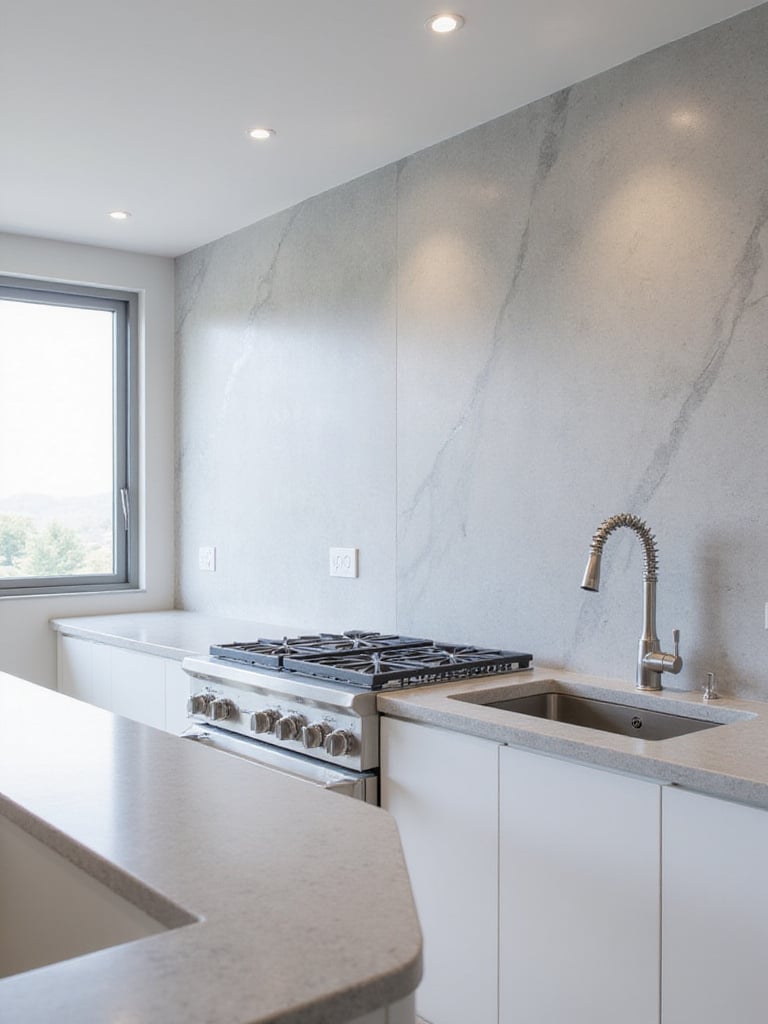
Before committing to large format tiles, ensure your substrate is perfectly flat and structurally sound. These larger pieces require expert installation to prevent cracking and ensure proper alignment—especially important when you’ll be mounting technology nearby. Consider how you’ll handle cuts around outlets and switches, particularly if you’re planning additional connections for smart devices.
Beyond aesthetics, the ecological impact matters because larger tiles often require less energy to produce per square foot than smaller formats, potentially reducing the carbon footprint of your kitchen renovation while creating the perfect canvas for your smart home integration.
In kitchens increasingly dominated by perfect screens and precise technology, Zellige tiles offer refreshing handcrafted character. These Moroccan-inspired tiles feature subtle variations in color, texture, and shape that provide organic visual relief from the uniform perfection of digital displays and smart appliances. Their slightly irregular surfaces catch light differently throughout the day, creating a dynamic backdrop that evolves as your smart lighting changes.

Light-colored Zellige tiles (ivory, pale blue, or soft gray) with matching grout create subtle texture without overwhelming your technology. The glazed surface still reflects light beautifully, enhancing visibility around work areas while the handcrafted nature adds warmth that technological elements often lack. This balance of reflectivity and texture makes Zellige an excellent companion to smart kitchens.
For those hesitant about bold patterns competing with their technology, Zellige offers the perfect middle ground—distinctive enough to add character but subtle enough to complement rather than compete with your smart kitchen features.
Extending your backsplash from countertop to ceiling creates a dramatic frame for your culinary technology. This approach makes a powerful design statement while providing maximum protection against cooking splashes—particularly valuable around ranges with smart temperature monitoring or behind areas with mounted tablets and screens. The vertical continuity draws the eye upward, making the kitchen feel more spacious and architecturally significant.

When planning a full-height backsplash, carefully consider material, color, and pattern scale. Lighter colors prevent the extended surface from feeling overwhelming, while subtle patterns add interest without competing with your technology. Consider incorporating open shelving to break up the expanse of tile and provide display space for both decorative items and smaller smart devices like speakers or digital assistants.
The visual weight balances perfectly when you pair a ceiling-height backsplash with integrated smart lighting—whether under-cabinet LEDs, pendant fixtures with voice control, or color-changing ambient systems that transform the mood of your kitchen throughout the day.
Combining open shelving with your backsplash creates a functional display system for both technology and treasures. This approach maximizes space utilization while providing convenient access to smart speakers, digital assistants, and tablet stands alongside everyday kitchen essentials. The backsplash protects the wall behind shelves from splashes and stains, ensuring both your technology and your space remain pristine.
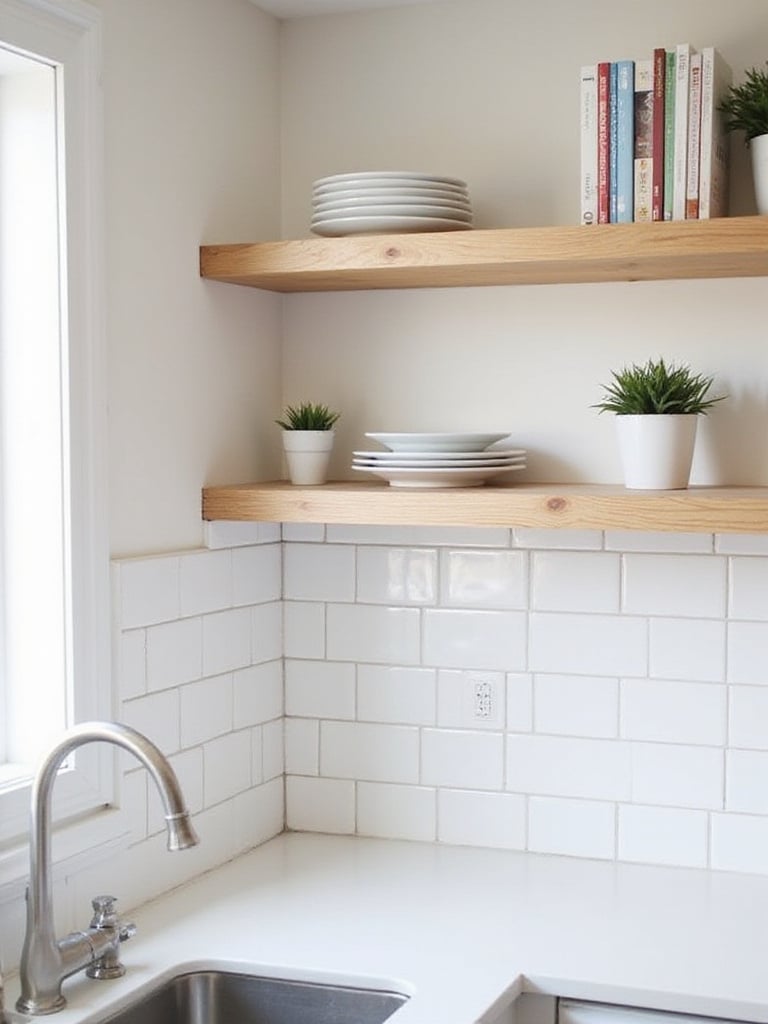
Material combinations create different effects—glass shelves against a tile backsplash emphasize lightness and transparency, perfect for displaying smaller tech devices without visual weight. Wood shelves against stone or tile add warmth and contrast, softening the technological elements. Metal shelving paired with coordinating backsplash materials creates an industrial-chic look that complements the technical nature of smart kitchen components.
While designed for the living room, we’ve seen creative uses in kitchens where floating shelves become natural homes for voice assistants and charging stations, seamlessly integrating technology into the heart of the home.
Creating visual continuity between your countertop and backsplash eliminates distracting transitions, allowing your smart kitchen technology to shine against a unified backdrop. This seamless approach is particularly effective in smaller kitchens or those with multiple tech integration points, as it reduces visual clutter and creates a more spacious feel. The uninterrupted surface also simplifies cleaning around areas with mounted screens or control panels.
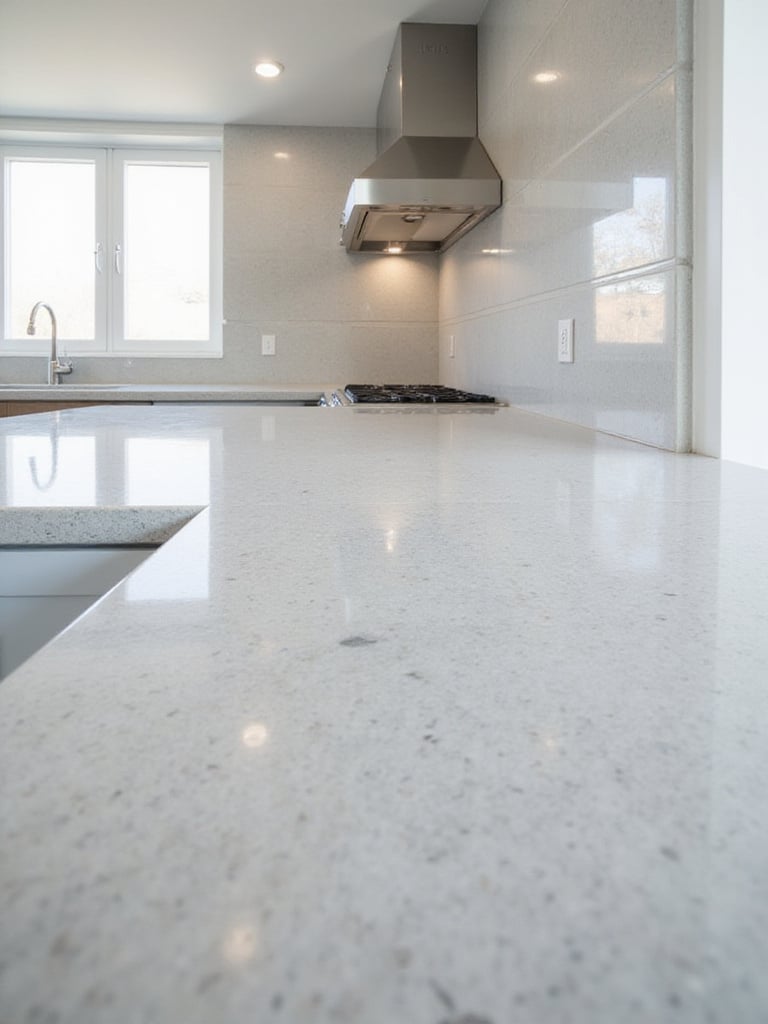
Materials like quartz, granite, marble, and solid surfaces work exceptionally well for this application. Quartz offers consistent patterning and exceptional durability around technology installations. Granite provides natural variation with excellent heat resistance near cooking zones. Marble delivers classic luxury but requires more careful protection around water-prone areas where technology might be installed.
What separates artisanal quality from mass-produced is attention to detail in these seamless installations—particularly how the material wraps around corners and how outlets and technology mounting points are integrated into the continuous surface.
Mirrored backsplashes perform double duty in smart kitchens—they dramatically enhance the sense of space while improving light distribution around technology. By reflecting both natural and artificial light, mirrored surfaces can reduce shadows around work areas and improve visibility of digital displays without increasing brightness settings. This light-amplifying effect is particularly valuable in smaller kitchens or those with limited natural light.
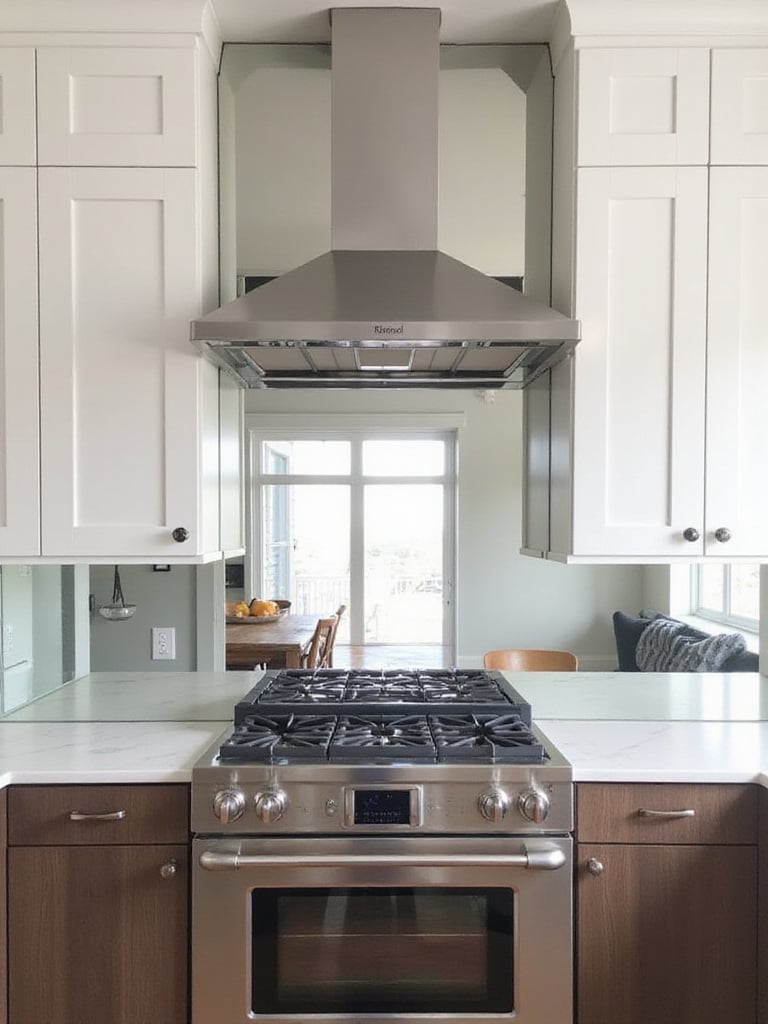
Various mirrored options offer different aesthetics and practical benefits. Full sheet mirrors provide maximum reflectivity and a seamless look. Mirrored tiles allow for more design flexibility and can incorporate patterns through arrangement. Antique mirror finishes add character while hiding fingerprints and smudges—a practical consideration in tech-heavy kitchens. Tinted mirrors in bronze or smoke gray can complement specific color schemes while reducing glare on nearby screens.
As morning light filters through, the texture creates fascinating reflections that change throughout the day, providing dynamic visual interest that complements rather than competes with your kitchen’s technological elements.
Wood backsplashes bring essential warmth and organic texture to technology-focused kitchens, creating balance between natural and digital elements. Hardwoods like teak, walnut, and maple offer excellent durability when properly sealed, while their varied grain patterns provide visual interest that softens the precise lines of smart appliances and screens.
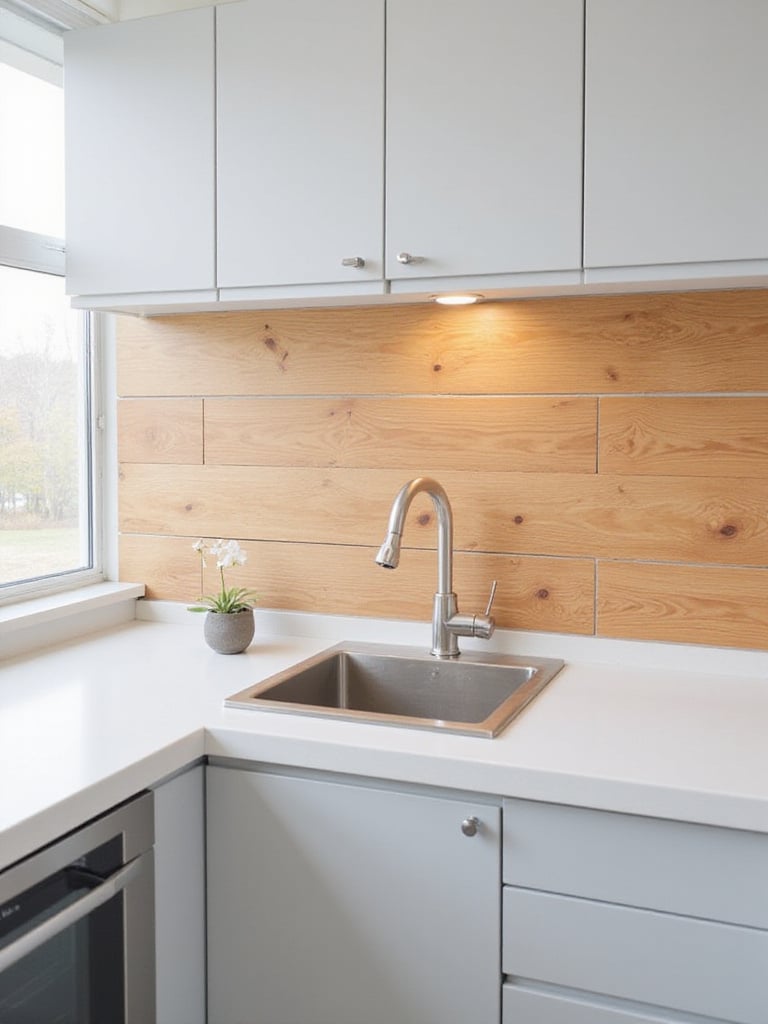
Protection is paramount with wood backsplashes—multiple coats of waterproof sealant designed specifically for kitchen environments are essential, particularly around areas with technology installations that might be sensitive to moisture. Consider adding a glass or metal panel behind the range to shield both the wood and any nearby technology from direct heat and grease splatters. Regular maintenance with appropriate cleaners will ensure your wood backsplash remains beautiful while protecting your tech investments.
This chameleon-like piece adapts to various styles by pairing differently with technology—walnut complements black screens and devices with warmth, while lighter maple creates contrast against darker tech elements for a more dramatic effect.
Exposed brick backsplashes introduce rugged character that beautifully counterbalances the sleek perfection of smart kitchen technology. The textural depth and dimensional quality of brick creates visual interest without the busyness of patterned tile, allowing your digital displays and smart features to remain prominent. This contrast between raw, traditional materials and cutting-edge technology creates a compelling design narrative in your kitchen.
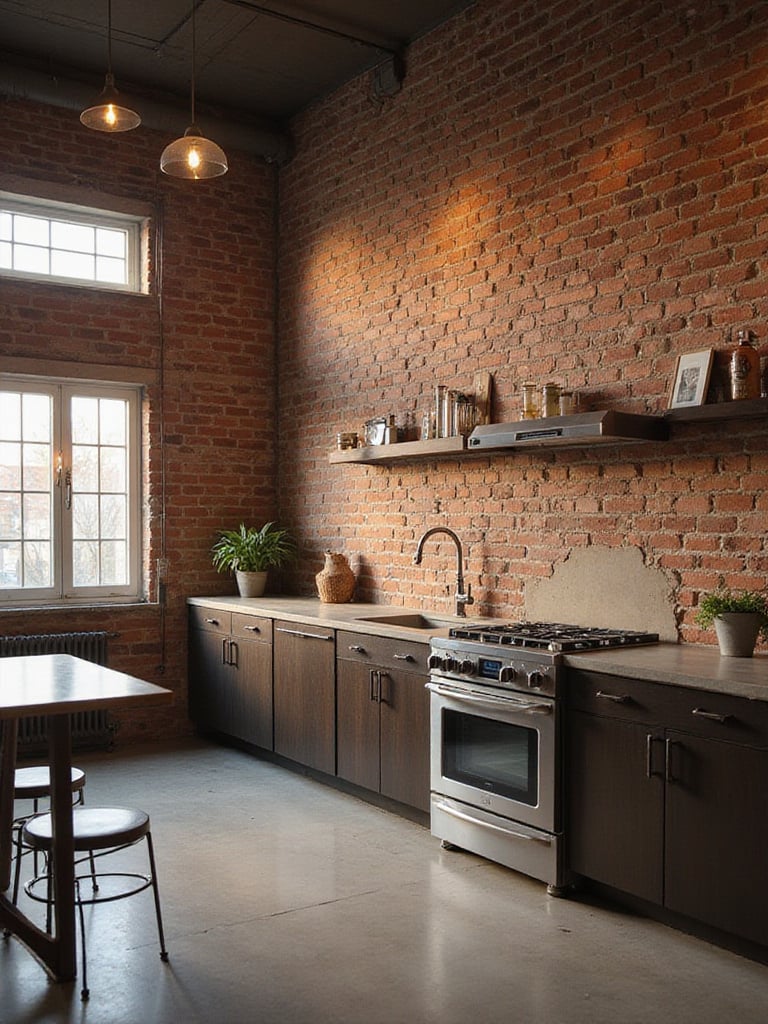
Consider painting exposed brick in lighter shades like white, cream, or light gray to create a more contemporary feel that won’t compete with your technology. Proper sealing is essential—use a breathable sealer designed for brick to protect against moisture and grease while maintaining the material’s natural texture and character. This protection is particularly important around areas with mounted screens or control panels that could be damaged by moisture migration.
The unexpected pairing that always works is industrial brick with integrated smart lighting—whether LED strips highlighting the texture from above or below, or strategically placed fixtures that cast interesting shadows across the uneven surface throughout the day.
For ultimate personalization in your smart kitchen, consider wallpaper protected by glass. This innovative approach allows you to create a completely custom backdrop for your technology—whether complementary patterns that enhance your design scheme or specifically chosen images that coordinate with your digital displays. The protective glass layer ensures durability and easy cleaning, making this surprisingly practical for kitchen environments.
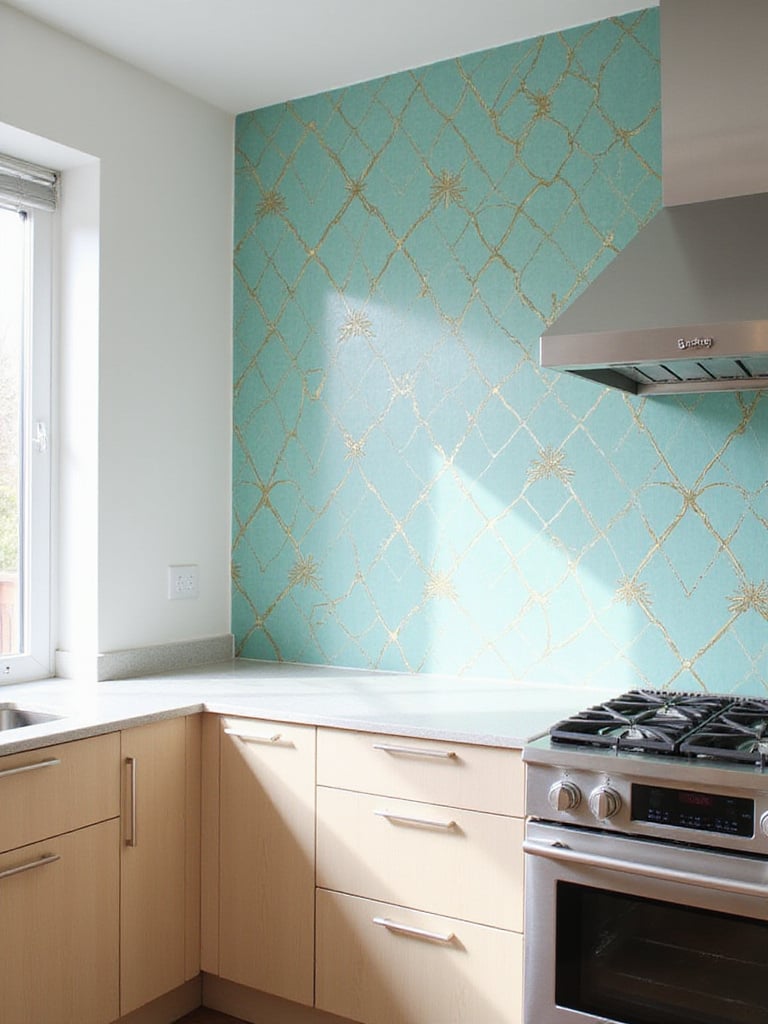
Select wallpaper with a matte finish to minimize glare that could affect visibility of screens and displays. Thicker, vinyl-based wallpapers provide the best durability during installation and behind the glass. The glass itself adds a modern, glossy element that enhances the contemporary feel of a tech-focused kitchen while protecting your custom design from moisture, grease, and damage.
The designer’s secret here is to choose a wallpaper pattern that complements rather than competes with your technology—subtle geometrics, tone-on-tone patterns, or custom digital prints that extend your smart home’s color scheme create cohesion between your physical and digital environments.
Herringbone patterns bring classical geometry and sophisticated movement to technology-centric kitchens. This timeless arrangement adds visual interest without overwhelming your smart displays and controls, creating a perfect balance between traditional craft and modern innovation. The diagonal lines of herringbone introduce energy and movement that can guide the eye toward or around technological elements as desired.
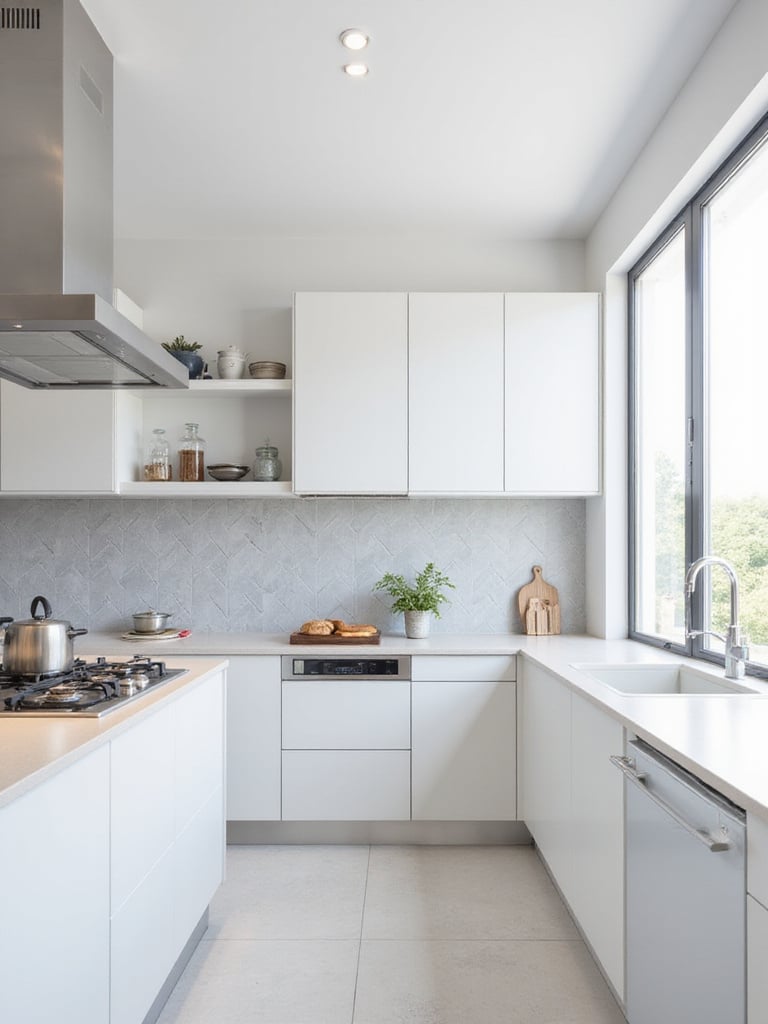
Material selection dramatically affects how herringbone interacts with your technology. Ceramic or porcelain in neutral tones creates a subtle backdrop that won’t compete with screens. Glass herringbone adds reflectivity that can enhance lighting around digital displays. Natural stone brings organic variation that softens the technological elements. Consider how different finishes—matte versus glossy—will interact with your smart lighting and reduce glare on screens.
When your existing decor doesn’t seem to coordinate with new technology, herringbone offers a transitional bridge—its classical roots connect with traditional elements while its geometric precision complements modern tech, creating harmony between different design elements in your kitchen.
Penny tiles bring playful geometry to smart kitchens, their small circular shape creating interesting contrast with the typically rectangular screens and devices of modern technology. This juxtaposition of organic rounds against digital squares and rectangles adds visual interest and prevents tech-heavy kitchens from feeling too rigid or sterile. The small scale of penny tiles creates a textural effect from a distance while revealing delightful detail up close.
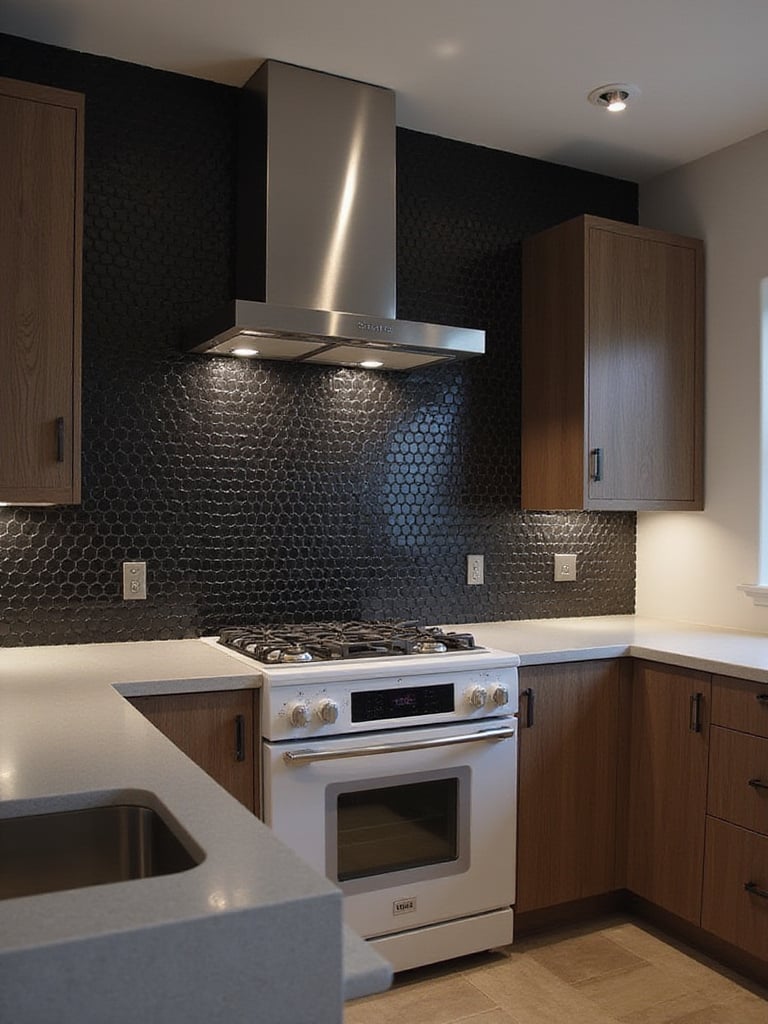
To keep penny tiles firmly in modern territory, opt for contemporary color choices—matte black, navy blue, or metallic finishes like copper or brass. Consider unexpected grout colors to create graphic impact that complements your technology. Limit penny tiles to specific areas rather than entire walls—perhaps behind a smart range or surrounding a digital hub—to create focal points without overwhelming the space.
The quality becomes evident after years of use when penny tiles maintain their appeal through changing technology trends—their classic shape has already stood the test of time once, making them a safe bet for longevity in your smart kitchen design.
Dark backsplashes create sophisticated contrast that makes illuminated displays and smart technology truly pop. Deep charcoal, navy blue, or black backsplashes provide the perfect backdrop for screens, digital controls, and LED-illuminated features, improving visibility and creating a high-end, immersive environment. This dramatic contrast also helps define different functional zones within your kitchen.
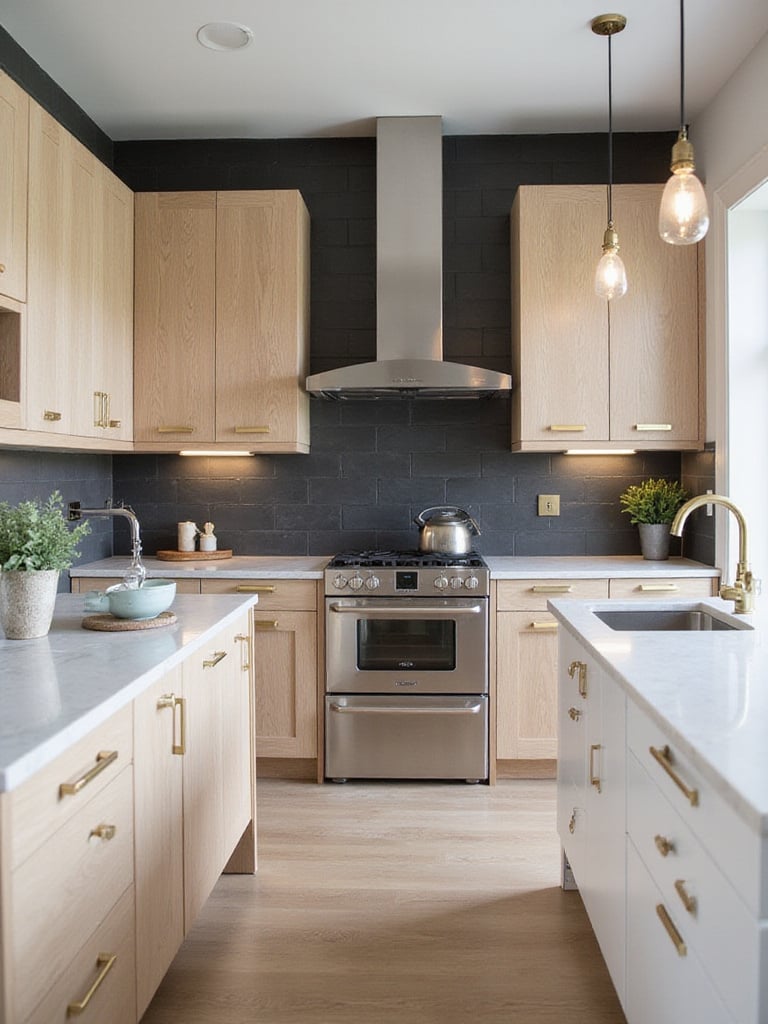
Material options for dark backsplashes are diverse—matte ceramic tiles reduce glare around screens, while glossy glass tiles can amplify light from smart fixtures. Natural stone like slate or dark granite adds textural interest that balances the sleek surfaces of technology. Consider how your chosen material will interact with fingerprints and cleaning needs, particularly around frequently touched control panels or displays.
Picture the warmth of evening conversations around your smart kitchen island, where voice-activated lighting dims to perfect ambiance against your dark backsplash, creating an atmosphere that seamlessly blends technology with comfort—the ultimate goal of any modern kitchen design.
The right kitchen backsplash for your modern, tech-integrated home should balance aesthetics with functionality, creating a backdrop that complements rather than competes with your smart features. Whether you prefer the clean minimalism of a seamless slab, the textural interest of natural materials, or the graphic impact of patterned tiles, your backsplash should work in harmony with your technology to create a cohesive, intuitive space.
Remember that lighting—both natural and smart-controlled—will dramatically affect how your backsplash appears throughout the day. Test materials under different lighting conditions before making your final selection. Consider how your chosen backsplash will interact with screens, displays, and control panels in terms of reflectivity, contrast, and visual compatibility.
By thoughtfully selecting from these 21 kitchen backsplash ideas for modern, tech-friendly homes, you’ll create a space that’s not just beautiful and functional, but truly smart—in every sense of the word.